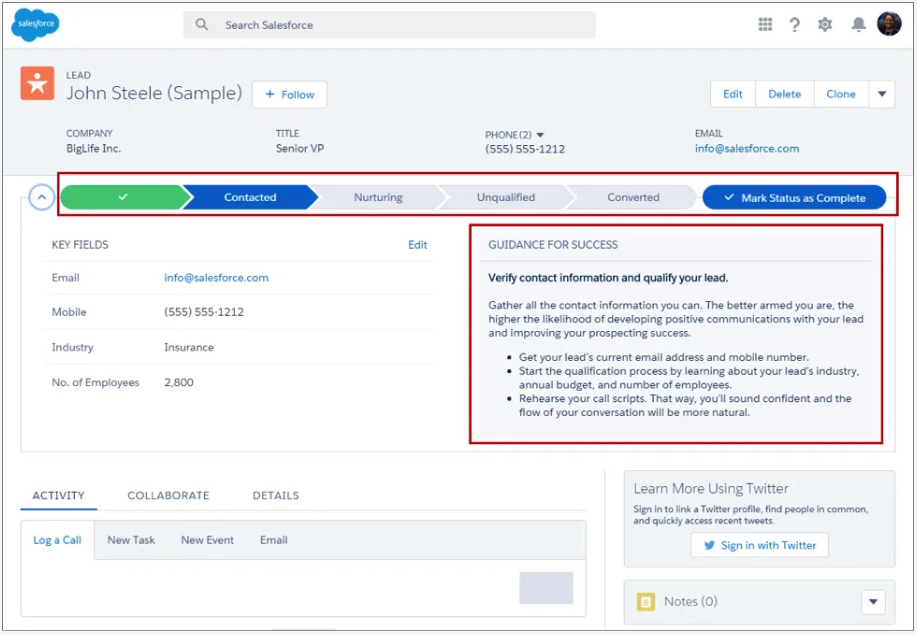The 5 P’s of Selling
What’s your Salesforce solution doing for your company? Is it the true strategic partner you hoped it would be, or is it seemingly nothing more than a glorified Rolodex or list manager? If the latter, you’re leaving value on the table!
Research shows that small businesses utilizing Salesforce increased their overall sales by 27 percent. At the same time, their win rates rose by 29 percent. Those are numbers no company can afford to ignore. But how do you get there? How do you turn your Salesforce solution from a list manager into a true sales support tool?

What are the 5 P’s of selling?
Salesforce is at its best when it’s increasing your sales productivity and providing support for your team, all while acting as a single source of truth for your data, leads, campaigns, accounts, contracts, activities and opportunities. Each of these metrics, as well as your CRM strategy, will be invaluable for the five P’s of selling:
- Preparation
- Plan
- Process
- Production
- Performance
Preparation
Before you can plan you have to prep by researching your competitors, partners, prospects and customers. This information will help you create viable plans for the next stage.
To flush out your information during the preparation phase, here are a couple of questions you should answer:
- Competitors: What’s their sales pipeline? How do they generate leads? What’s their customer profile?
- Partners: How can your partners complement your sales strategy? Where do you risk doubling up services?
- Prospects: Think BANT. What’s their Budget? Who has Authority? What’s the Need? How aggressive is their Timing?
- Customers: Have there been any organizational changes recently? Do the decision makers change if you’re trying to grow the account or sell new products?
Plan
Once you’ve finished your preparations and answered the questions above, you can begin formulating your plans — each of which should be created, documented, socialized and managed in Salesforce.
Here’s a brief look at the four essential plans.
1. Your marketing plan. This plan will include your strategy for garnering qualified leads into the sales pipeline as well as your efforts to generate those leads via personalized content and media exposure. These leads should be tracked by Campaigns in Salesforce.
2. Your sales plan. The cornerstone of your future success. This plan should include your strategies for selling to new, existing and strategic accounts. Much of the data we gathered in the preparation step will live in this plan as well as in your marketing plan. You can also simplify your sales plan by creating convenient processes for your reps in Salesforce.
3. Your delivery plan. You may have otherwise heard of this as your operations plan. Simply put, this is your strategy for delivering on everything your sales team promised. Create custom workflows and dashboards to support these efforts in Salesforce and you’ll simplify the process while gaining additional clarity.
4. Your support plan. Customer service is king, and this plan will outlay your strategies for maintaining customer satisfaction and spurring renewal business. Your Salesforce solution can support you here as well by allowing you to track past customer engagements in order to personalize future interactions.
Each one of these plans represents a phase in the customer journey that begins with them finding you via your marketing efforts and ends with them enjoying the customer support you provide.
Process
Now let’s look at your processes, or the strategic steps you will use to carry out your plans. There are several processes that will need to be created, documented, socialized and managed in Salesforce. Here’s a look at each, as well as the questions your process should answer.
1. Lead process – Examples of stages that a lead goes through to be processed by the marketing team can include: “Open,” “Contacted,” “Nurturing,” and “Unqualified.”

Considerations in determining lead status include:
- Where did the lead come from?
- Was the lead generated as part of a campaign?
- Who should own the lead?
- What are your minimum criteria for a Marketing Qualified Lead (MQL)?
- How will you convert the lead into a contact, account or opportunity, and follow up tasks for sales?
- How will you nurture the lead if they are not ready to buy yet?
- How will you score leads based on their behavior so you can focus on the most promising leads?
- Do you need marketing automation?
Finally, do you need different lead processes?
2. Sales process – The stages an opportunity goes through to progress to a sale can include: prospect, meeting, estimate, proposal, contract, negotiation, closed-won or closed-lost.
As an opportunity moves through these stages, you’ll want to consider:
- What is the likely dollar amount of the opportunity?
- Who are the people that will influence the sale?
- What is the probability of successfully winning the opportunity by the sales stage?
- Who are the competitors and partners on the opportunity?
- If you lost the opportunity, why did you lose it?
- How long should each sales stage take?
- How do you do your quoting?
- When will the deal close?
- Finally, do I need multiple different sales processes?
3. Support process – At some point each customer service case will go through the open, working, waiting and closed stages.
During these stages you’ll need to know:![]()
- Is customer self-service possible?
- Can I use knowledge for call deflection?
- Would a live chat option make sense?
- What was the root cause of the case?
- Do I need to make sure customers are entitled to support?
- Should I charge for support?
- Would call scripts be useful?
- Do I need to establish Service Level Agreements (SLAs)?
- Do I need manage my calls from within Salesforce?
- Do I need multiple different support processes?
Production
Now it’s time to talk production.
You’ve heard the proof is in the pudding, but in business the proof is in the production. This is where all your plans and processes come to fruition, and their success will be determined by the number of leads, closed opportunities and retained customers they generate.
The ultimate success of your results relies on having sales data up-to-date in Salesforce, particularly: tasks, leads, accounts and opportunities. This is a challenge for many sales teams, and if yours struggles to complete such information, workflows and automated data entry tools can ensure the validity of your data. It can also help your sales team get back to what they do best: selling.
Performance

We’ve come to the final P and now it’s time to see how you’re performing. Whether you’re a manager, a marketer or a member of a sales or customer service team, your team’s performance against plan is pivotal.
Establishing SMART (Specific, Measurable, Actionable, Results Orientated, Time Bound) goals and measuring them each quarter is a sound strategy. Your findings should then all be tracked through your Salesforce dashboard.
You can also use Salesforce to:
- Define your KPIs. Prioritize your goals and your metrics.
- Set your pipeline and booking targets. Your reps have a visible goal and you have a course to correct as necessary.
- Manage your performance. Use central dashboards as your single source of truth and employ mobile tactics — especially the Salesforce1 Mobile App — to give everyone access no matter where they need it.
- Constantly inspect your pipeline. Salesforce’s AMP dashboard makes it easy to see the links between your activity and your pipeline and where you can strengthen both.
- Establish a business review schedule. Monthly, quarterly or both, these reviews, run through Salesforce, give your team a comprehensive look at the necessary data. This allows you to learn from what hasn’t worked and chart a more refined path for the coming month or quarter.
Putting it all together
We’ll close with one final P: path. Each of the five P’s discussed above are a vital component in not only your own sales path, but the overall Path to Success for a sound CRM strategy. Your Salesforce solution, empowered with the proper data, is your navigator along this path, capable of steering you in the right direction every step of the way.
So don’t shy away from this potential. Empower your Salesforce and you’ll transform that old list manager into the truly strategic partner your company deserves.
To learn more about how Redpath can help your company enhance your Salesforce solution to truly master the 5 P’s of selling, contact us.
Editor’s note: This post was originally published on 8/29/16. It has been updated with new information and insight.
With the rapid evolution of technology, Salesforce solutions are ever-changing and improving features. Contact our team for up-to-date information.

